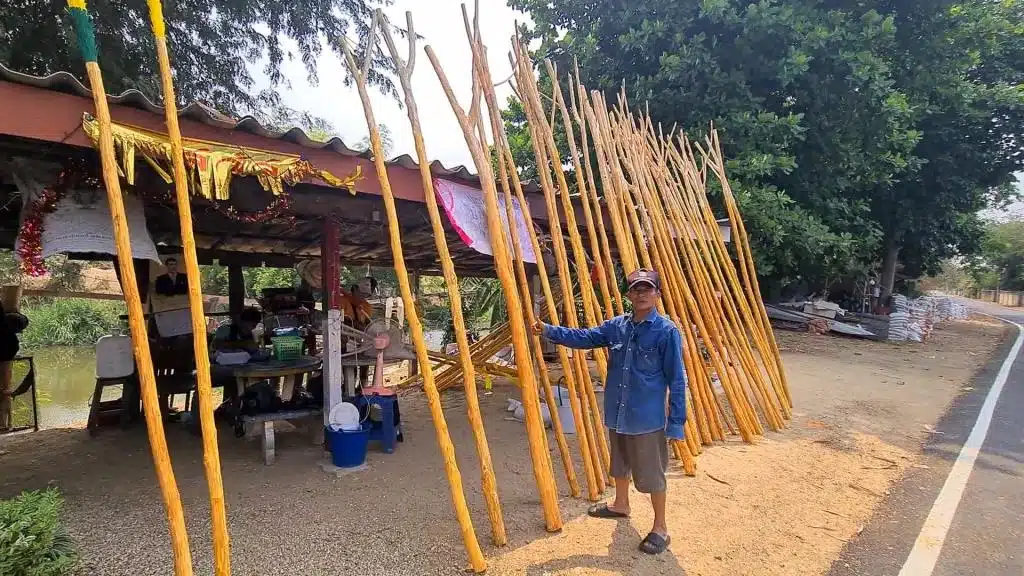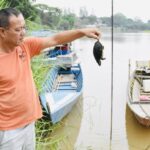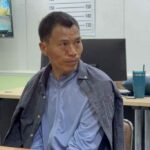In Lampang, a couple is busy producing traditional “Mai Kam Bo” to meet demand for the upcoming Thai New Year. With just 10-12 days of work before Songkran, they’ve already earned tens of thousands of baht.
As Songkran, the traditional Thai New Year, approaches, locals in northern Thailand are preparing items for important ceremonies. A key ritual on April 15, known as “Wan Phaya Wan,” involves bringing sand to temples and offering “Mai Kam Bo,” or sacred support poles.
According to ancient beliefs, these poles symbolise stability and prosperity for families.
“Mai Kam” are wooden poles of varying sizes with forked ends for support. They are decorated with colourful paper and used to support the sacred Bodhi tree, a symbol of the Buddha, commonly found in temples.
Nowadays, many people choose not to make these poles themselves due to the time, effort, and materials required. Instead, a local husband and wife team, Pha and Pat Kanjai from Ban Nam Thong, Bo Haeo Subdistrict, Lampang, have stepped in to fill the gap.
They’re currently working hard to keep up with orders during this festive season.

Pha explained that they source softwood, locally known as “Mai Phak Nong,” from nearby gardens. This wood is easy to work with and needs to meet specific criteria: it must be straight, have 2-4 forks at the top, and stand at least 3.5 metres tall.
The wood also needs to be around 3-4 months old for optimal quality.
Once the wood is collected, the process begins. The bark is stripped, the poles are left to dry in the sun, and then sanded smooth to remove splinters. A layer of turmeric paste is applied to give the wood a bright yellow hue, a traditional colour believed suitable for temple offerings.
After drying, the poles are decorated with seven different colours of paper to make them visually appealing.

Ms. Pat shared that they stay true to traditional methods, using turmeric as a natural colourant, which is part of their cultural heritage. Though fewer people now make these poles themselves, the couple continues the practice, passing it down from previous generations.
They spend about 10-13 days crafting the poles, earning over 10,000 baht each year. Prices range from 80 to 200 baht, depending on size and the number of forks. Special pieces, such as larger poles with four forks, cost slightly more.
This year, they expect to produce around 100 poles based on current orders. Those interested can place their orders until April 13 by contacting them at 09-7972-3106 or 08-6054-2767.
Thai New Year Northern Thailand
The Thai New Year, known as Songkran, is a vibrant and culturally rich celebration in Northern Thailand, particularly centered around the traditional Lanna customs of the region. Songkran typically takes place from April 13 to 15 each year, marking the traditional start of the new year when the sun moves into the Aries constellation.
In Northern Thailand, especially in cities like Chiang Rai, the festival blends ancient rituals with lively modern festivities, making it one of the most anticipated events of the year.
In Northern Thailand, Songkran celebrations often extend beyond the official three days, sometimes lasting up to a week. The festival is deeply rooted in Buddhist traditions and serves as a time for renewal, purification, and community bonding.
A key ritual is the pouring of water, which symbolizes cleansing and good fortune.
In the Lanna tradition, people visit temples to pour water over Buddha images using a naga-shaped waterspout, a practice distinct from other regions where water might be sprinkled directly. This act, known as Song Nam Phra, is a way to honor sacred images and wash away misfortunes from the past year.
Related News:
Tourism Authority Launches Songkran Tan Tung for Chiang Rai and Phayao

Geoff Thomas is an award winning journalist known for his sharp insights and no-nonsense reporting style. Over the years he has worked for Reuters and the Canadian Press covering everything from political scandals to human interest stories. He brings a clear and direct approach to his work.














